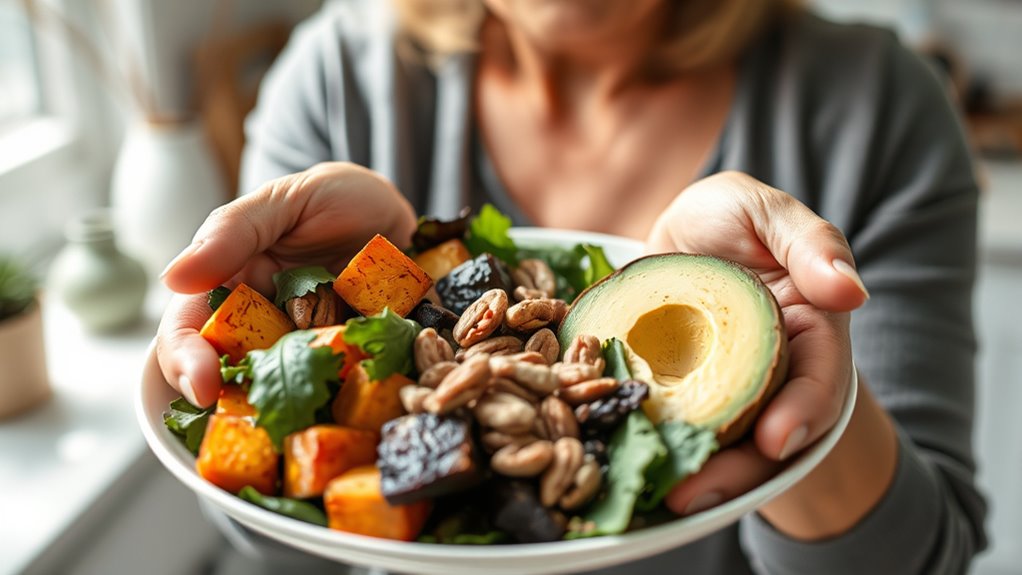As a woman over 40, hormonal shifts during menopause cause fluctuating estrogen and progesterone levels, which disrupt hunger and fullness signals. This imbalance increases cravings for sugar and carbs, especially when ghrelin rises and insulin resistance develops. Stress and disrupted sleep further elevate cortisol, boosting appetite for comfort foods. These hormonal and metabolic changes make carb cravings more intense. To learn effective ways to manage these cravings, explore the strategies that follow.
Key Takeaways
- Hormonal fluctuations after 40, especially declining estrogen and progesterone, disrupt hunger and satiety signals, increasing cravings for carbs.
- Elevated cortisol and stress levels activate brain reward pathways, prompting emotional eating and a preference for carbohydrate-rich comfort foods.
- Insulin resistance causes blood sugar fluctuations, leading to frequent carb cravings and difficulty managing weight.
- Sleep disturbances common over 40 elevate ghrelin and reduce leptin, boosting appetite and carb-seeking behaviors.
- Changes in metabolism and mood due to hormonal shifts make women more prone to crave high-carb, sugary foods for comfort.
Hormonal Fluctuations During Menopause

Hormonal fluctuations during menopause substantially impact women’s appetite and cravings, especially for carbohydrates. As estrogen and progesterone levels decline, your body’s hunger signals become more erratic. Leptin, the hormone that suppresses appetite, may become dysregulated, making you feel hungrier and more prone to cravings. Meanwhile, ghrelin, which stimulates hunger, can stay elevated or more active, making it harder to feel full. Changes in insulin sensitivity can cause blood sugar dips, triggering carb cravings to restore energy. Stress-related cortisol fluctuations can further boost appetite and increase the desire for high-carb comfort foods. Additionally, alterations in peptide YY (PYY) reduce feelings of fullness, encouraging overeating of carbs. These hormonal shifts directly influence your desire for quick energy sources. Incorporating Glycolic Acid Exfoliating Toner into your skincare routine can also enhance skin renewal and improve overall skin health during this transitional phase.
The Impact of Estrogen Decline on Food Cravings

As estrogen levels decline during menopause, many women notice a significant increase in cravings for comfort foods, especially carbohydrates. This hormone helps regulate appetite by influencing hormones like leptin and ghrelin, which signal fullness and hunger. When estrogen drops, leptin signaling weakens, making you feel less satisfied after eating. At the same time, estrogen’s inhibition of ghrelin decreases, leading to increased hunger. Additionally, fluctuations in hormone levels can impact the contrast ratio, affecting how well you perceive the fullness of a meal and potentially contributing to overeating. These hormonal shifts can also influence metabolic rate, making it more challenging to maintain a healthy weight during this stage of life.
How Progesterone Levels Affect Hunger and Satiety

Progesterone plays a significant role in regulating your appetite by directly influencing hunger hormones like ghrelin and leptin. When progesterone rises during the luteal phase, it stimulates ghrelin, the hunger hormone, making you feel hungrier. At the same time, it reduces leptin, the hormone responsible for signaling fullness, so you don’t feel satisfied as easily. This hormonal shift increases your cravings for high-carb, sugary, and salty foods, especially in the second half of your cycle. Additionally, progesterone affects serotonin levels, which can influence your mood and food cravings. These changes can lead to increased appetite, making it harder to resist carbohydrate-rich snacks. Hormonal fluctuations such as these can also contribute to emotional eating and carb cravings during certain times of the month. Understanding how these hormonal changes impact hunger can empower you to develop strategies to manage cravings more effectively, especially when you recognize the role of hormones in driving food preferences.
The Role of Ghrelin in Increasing Carbohydrate Hunger

Ghrelin, often called the “hunger hormone,” plays a central role in signaling your brain when it’s time to eat. Produced mainly in your stomach when it’s empty, ghrelin increases your appetite and prompts food intake. It’s especially influential in craving carbohydrates, as elevated ghrelin levels heighten your desire for high-calorie, carb-rich foods. Ghrelin also affects taste sensation, making carbs more appealing, and promotes reward-seeking behaviors that encourage carb consumption. Additionally, it influences carbohydrate metabolism by stimulating gluconeogenesis, decreasing insulin sensitivity, and impacting how your body handles glucose. For women over 40, hormonal shifts can alter ghrelin levels, intensifying carb cravings. Understanding this hormone’s role can help you develop strategies to manage those persistent urges for comfort foods, especially considering how Volkswagen Tuning modifications can impact metabolic responses and energy expenditure. Recognizing the connection between hormonal fluctuations and ghrelin levels can provide further insight into managing cravings during this life stage.
Insulin Resistance and Its Effect on Cravings

Insulin resistance directly impacts your cravings by causing blood sugar levels to fluctuate unpredictably, which can trigger your body’s urge to seek quick energy sources like carbohydrates. When your cells don’t respond effectively to insulin, excess glucose remains in your bloodstream, leading to spikes and crashes in blood sugar. These rapid changes often stimulate intense cravings for sugary or carb-rich foods as your body tries to restore balance. During menopause, hormonal shifts can worsen insulin resistance, making cravings even harder to control. Consuming too many simple carbs worsens this cycle, further impairing insulin sensitivity. Additionally, body composition management can help improve insulin sensitivity and reduce cravings. Incorporating labradoodle names and other strategies like balanced meals and regular activity can help stabilize blood sugar, reduce cravings, and improve overall insulin function. Incorporating physical activity into your routine is also proven to enhance insulin sensitivity and support hormonal health during this stage of life.
Sleep Disruptions and Their Influence on Hunger Hormones

Sleep disruptions can markedly influence hunger hormones, making it harder to control cravings for carbs and sugary foods. When your sleep is disturbed, ghrelin levels rise, increasing your appetite, while leptin levels drop, reducing your sense of fullness. This hormonal imbalance drives you to eat more, especially in the evening when cravings often hit hardest. During menopause, hormonal fluctuations further disrupt sleep, amplifying these effects. Poor sleep quality also decreases levels of satiety hormones like peptide YY and GLP-1, making you feel less satisfied after eating. As a result, you may find yourself craving high-carb, calorie-dense foods more often. Addressing sleep issues can help rebalance these hormones, reducing cravings and supporting healthier eating patterns over time. Additionally, home theatre projectors can create a relaxing environment that may improve sleep quality by reducing stress and promoting a calming atmosphere. Sleep hygiene practices, such as maintaining a consistent sleep schedule and limiting screen time before bed, are also effective in promoting restorative sleep and hormone balance. Moreover, incorporating mindfulness techniques can further help reduce stress-related sleep disruptions, benefiting hormone regulation and appetite control. Developing a regular sleep routine can also help stabilize these hormonal fluctuations, making cravings more manageable. Furthermore, engaging in relaxation exercises can assist in calming the nervous system and improving overall sleep quality, aiding in hormonal balance and appetite regulation.
The Connection Between Cortisol and Craving High-Carb Foods

Cortisol plays a crucial role in influencing your metabolism and appetite, especially when you’re under stress. Elevated cortisol levels can boost glucose release from your liver, making you crave carbs. It also activates neuropeptide Y and dopamine, which ramp up your desire for high-carb, energy-dense foods. When cortisol is high, your hunger hormones like ghrelin increase, while signals for fullness, like leptin, weaken. This imbalance pushes you toward carbohydrate-rich snacks. Additionally, increased cortisol levels are associated with Automation in Business, which can contribute to heightened stress and cravings. You might notice: – Increased cravings for sweets and starchy foods during stress – A tendency to eat more carbs when cortisol spikes – Faster fat storage around your midsection – A preference for comfort foods that are high in carbs – Disrupted hunger signals leading to overeating, especially when stress levels remain elevated over time.
Emotional Stress and Its Drive to Seek Comfort Foods

When you’re under emotional stress, you might find yourself craving comfort foods, especially carbs, to feel better. Stress triggers hormonal changes that boost your appetite and increase these cravings, making it harder to resist indulgence. Recognizing this pattern can help you develop healthier ways to cope and manage your emotional eating. Incorporating stress management techniques can create a calming and organized environment that supports your mental well-being. Additionally, understanding the role of hormonal fluctuations can empower you to make more mindful food choices during stressful times. Being aware of how paint sprayer performance varies can also serve as a metaphor for understanding how your body responds to stress and the importance of choosing the right tools for health.
Stress Triggers Cravings
Emotional stress often triggers intense cravings for comfort foods, especially those high in carbohydrates. When you’re stressed, your brain’s reward pathways activate, making carb-rich foods even more appealing. Cortisol, the stress hormone, boosts your appetite and sharpens your preference for sugary and starchy foods. This hormonal shift reduces feelings of fullness, encouraging you to eat beyond hunger. As a result, you might find yourself reaching for that bag of chips or a sweet treat even when you’re not hungry. Stress also rewires your brain’s circuits, reinforcing habitual cravings for carbs. Over time, this cycle can lead to overeating and weight gain. Recognizing these triggers helps you break the pattern and develop healthier coping strategies. Additionally, understanding how sleep impacts your emotional regulation can be a useful tool in managing cravings.
Emotional Comfort Foods
Stress often prompts women over 40 to seek out comfort foods as a way to soothe emotional distress. These foods are deeply connected to your feelings, offering psychological comfort and pleasure through dopamine release. They often evoke nostalgia, transporting you back to moments of safety and warmth, which enhances their emotional appeal. The sensory qualities—creamy textures and rich flavors—make comfort foods especially enticing during tough times. Eating them provides a sense of solace, helping to regulate your emotions and temporarily lift your mood. Social ties also play a role; comfort foods remind you of gatherings and family, reinforcing feelings of belonging. Overall, these foods serve as a quick emotional escape, offering familiarity and security when you’re overwhelmed.
Cortisol and Appetite
Cortisol, a hormone released in response to stress, plays a significant role in controlling your appetite and cravings. When stress levels rise, cortisol increases, making you hungrier and craving comfort foods like carbs. During menopause, hormonal fluctuations reduce estrogen’s calming effect on cortisol, amplifying this response. Elevated cortisol not only sparks hunger but also drives the desire for high-calorie, carbohydrate-rich foods, leading to weight gain. Managing cortisol is essential for controlling these cravings and maintaining a healthy weight.
- You might reach for snacks when stressed, seeking comfort.
- Increased cortisol can make you crave sweets and carbs.
- Stress triggers hormonal changes that boost appetite.
- Sleep disturbances from menopause can raise cortisol levels.
- Techniques like exercise and relaxation help keep cortisol in check.
Life Changes and Their Effect on Stress Levels

Life changes, like managing family responsibilities or going through a divorce, can quickly raise your stress levels. These shifts often bring emotional turmoil and shifts in social and family dynamics that make coping harder. As your stress increases, it can influence your cravings and overall well-being.
Major Life Transitions
Major life shifts can considerably influence your stress levels, especially as you maneuver changes like career shifts, family dynamics, and health concerns. These transitions can trigger emotional responses that affect your eating habits and cravings. For example, a career change might bring financial worries, while children leaving home can cause feelings of loss. Health issues like osteoarthritis add daily stress, making it harder to stick to healthy routines. Adjusting to new social roles, such as becoming a caregiver, can also heighten stress. During these times, your body produces more stress hormones, which can increase carb cravings and impact your well-being.
- Handling career changes and financial worries
- Coping with children leaving home
- Managing health concerns like joint pain
- Navigating shifts in social roles
- Adapting to menopause-related changes
Increased Emotional Stress
Managing substantial changes in your personal and professional life can considerably heighten emotional stress, especially after 40. As you navigate these shifts, your body’s stress response becomes more intense—women experience three times greater impact than men. During late perimenopause and postmenopause, psychological distress rises, with prevalence rates around 22-25%. Fluctuating hormones like estrogen and progesterone contribute to mood swings, depression, and anxiety, making emotional regulation more difficult. Stressful experiences in middle age can also impair memory and cognitive function temporarily. Additionally, increased health concerns and physical changes add to your emotional burden. Without strong social support or effective coping strategies, this accumulated stress can become overwhelming, intensifying feelings of distress and making it harder to manage cravings for comfort foods like carbs.
Social and Family Changes
As women move through midlife, they often encounter a variety of social and family changes that can markedly elevate stress levels. These shifts include managing adolescent children, dealing with divorce or separation, or caring for aging parents. Such transitions can make you feel overwhelmed, especially when balancing work and home life. Financial concerns, like tuition or healthcare costs, add to the pressure. Additionally, adjusting to new roles, such as becoming an empty nester, can create feelings of loss or loneliness. A decline in social support networks may leave you feeling isolated during these times.
- Managing teenage or adult children’s needs
- Navigating divorce or relationship changes
- Caring for aging parents
- Facing financial pressures
- Adjusting to new life roles
Coping Mechanisms and Preference for Carbohydrate-Rich Foods

Hormonal fluctuations during midlife markedly influence how women cope with stress and emotional challenges, often leading to a preference for carbohydrate-rich foods. These changes lower serotonin, impacting mood and sleep, prompting you to seek comfort in carbs. Fluctuating estrogen and progesterone affect insulin sensitivity, causing blood sugar swings that trigger cravings for sweets or starchy foods. Rising cortisol levels promote urges for fatty, salty, or sugary comfort foods to manage stress. Fatigue also drives you toward quick energy sources like sugars and simple carbs, which give short-term relief but lead to energy crashes. Understanding these mechanisms helps you develop better coping strategies.
| Hormonal Changes | Food Preferences |
|---|---|
| Lower serotonin production | Seek comfort in carbs |
| Blood sugar fluctuations | Cravings for sweets and starchy foods |
| Increased cortisol levels | Preference for fatty, salty foods |
| Fatigue and energy needs | Cravings for quick energy sources |
Metabolic Slowdown With Age and Its Impact on Cravings

With age, your metabolism gradually slows down, impacting how many calories your body needs daily. This slowdown happens about 0.7% per year after 60, largely due to muscle loss, decreased activity, and hormonal shifts. As your metabolic rate declines, you need fewer calories, and weight tends to increase between 40 and 66, then stabilizes. This slowdown makes it easier to gain fat if you keep eating the same, high-calorie diet. You might notice more cravings for carbs as your body tries to compensate for this change.
- Loss of muscle mass reduces calorie burning
- Less physical activity lowers your metabolic rate
- Hormonal shifts affect hunger and fat storage
- Eating habits might need adjusting to prevent weight gain
- Cravings increase as your metabolism slows
Blood Sugar Fluctuations Triggering Carbohydrate Desires

Blood sugar fluctuations play a significant role in triggering carbohydrate cravings, especially in women over 40. When you eat refined carbs, your blood sugar spikes quickly, causing a sharp energy boost followed by a crash. This crash signals your body to seek quick energy, often in the form of sweets or carbs. Skipping meals can also lower blood sugar, intensifying these cravings. Rapid glucose changes affect your energy and mood, making you feel tired, irritable, and more likely to reach for comfort foods. Maintaining steady blood sugar levels through balanced meals with protein, fiber, and healthy fats helps prevent these spikes and crashes. By stabilizing your blood sugar, you can reduce the intense carbohydrate urges that often disrupt your well-being.
Hormonal Shifts Altering Metabolic Efficiency

As women over 40 experience hormonal shifts, their metabolic efficiency often decreases, making it harder to burn calories effectively. Lower estrogen levels reduce your metabolic rate, leading to slower calorie burning. These changes also shift fat distribution, favoring abdominal fat instead of hips and thighs. Additionally, decreased estrogen impacts insulin sensitivity, raising insulin levels and affecting sugar metabolism. Thyroid imbalances, such as hypothyroidism, further slow your metabolism, causing fatigue and weight gain. Elevated cortisol from stress promotes visceral fat storage and hampers glucose use, while declining progesterone disrupts hunger signals, increasing cravings for carbs. Combined, these hormonal shifts weaken your body’s ability to efficiently process nutrients, heightening your desire for quick energy sources like carbohydrates.
- Slower calorie burning
- Increased abdominal fat
- Insulin resistance
- Elevated stress hormones
- Disrupted hunger signals
Managing Blood Sugar to Reduce Cravings

Maintaining stable blood sugar levels is essential for reducing carb cravings, especially for women over 40 experiencing hormonal shifts. To do this, focus on eating complex carbohydrates instead of simple sugars, and include a variety of vegetables in your meals. Balance your macronutrients by adding healthy fats and proteins, which help slow blood sugar spikes. Prioritize protein and vegetables before carbs, and aim for a moderate carbohydrate intake rather than very low-carb. Incorporate healthy snacks between meals, and avoid eating sweets alone—consume them after a meal to minimize blood sugar fluctuations. Keeping meal times consistent also helps regulate blood sugar. Regular physical activity, especially strength training, boosts insulin sensitivity and stabilizes blood sugar levels, making cravings easier to manage.
How Skipping Meals Can Increase Carb Cravings

When you skip meals, your blood sugar drops, signaling your body to seek quick energy sources like carbs. This triggers hunger signals and hormonal disruptions that make cravings worse. As a result, avoiding meals can unintentionally increase your desire for carbohydrate-rich foods.
Blood Sugar Drop
Skipping meals causes your blood sugar levels to drop sharply, triggering intense cravings for quick energy sources like carbs. When your blood sugar dips, your body responds by releasing hormones like glucagon and epinephrine to raise glucose levels. This hormonal response increases hunger and makes high-carb foods more appealing. As a woman over 40, hormonal fluctuations can intensify these effects, making cravings even stronger.
You might notice:
- Sudden hunger just a few hours after skipping a meal
- A strong desire for sweets or bread to restore energy
- Feeling irritable or tired due to low blood sugar
- Increased cravings as your body seeks quick fixes
- Repeated cycles of blood sugar drops and spikes, leading to overeating
Increased Hunger Signals
Prolonged fasting from skipping meals triggers your body’s hunger signals to intensify, often leading you to overeat at your next meal. When you skip meals, your body perceives a threat to energy availability, activating survival mechanisms that boost hunger signals. This heightened hunger causes you to eat more and often crave quick-energy, high-carb foods like sweets or fast food. The longer the gap between meals, the stronger these signals become, making it harder to choose healthier options. Your brain responds to this increased hunger with a surge in ghrelin, the hunger hormone, which amplifies cravings for carbs. This cycle isn’t due to lack of willpower but is driven by your body’s natural physiological response to fasting, making carb cravings more intense after skipped meals.
Hormonal Disruption Effects
Hormonal changes that occur around menopause can considerably influence your hunger and cravings, especially for carbs. When you skip meals, your blood sugar drops suddenly, prompting your body to seek quick energy sources like carbs. This fluctuation can amplify cravings and make it harder to stick to healthy eating habits. Skipping meals also triggers emotional responses, leading to feelings of deprivation and overeating later. Additionally, hormonal shifts affect metabolism and nutrient absorption, increasing the desire for comfort foods. These changes create a cycle that intensifies carb cravings over time.
- Blood sugar swings cause intense cravings for quick carbs
- Feeling deprived leads to overeating high-carb snacks
- Hormonal shifts disrupt metabolism, increasing hunger
- Nutrient deficiencies heighten desire for carbs
- Stress from skipping meals triggers emotional eating
The Effect of Physical Activity on Energy Needs and Cravings

Physical activity markedly influences energy needs and cravings in women over 40 by elevating metabolic rate and increasing daily calorie expenditure. Regular aerobic exercise boosts resting metabolic rate (RMR), especially in women aged 49 to 70, supporting higher baseline energy demands. Active women burn more calories daily—around 13 MJ—compared to less active peers, who may only expend 9 MJ. This increased energy use often leads to stronger cravings, especially for carbs, as your body seeks quick glycogen replenishment.
| Activity Level | Daily Energy Expenditure | Typical Cravings |
|---|---|---|
| Sedentary | ~9.3 MJ | Moderate |
| Moderately Active | ~12.99 MJ | Increased |
| Very Active | Up to 18.15 MJ | Strong |
| Long-term Exercise | Sustained higher RMR | Persistent |
| Age-related decline | Slowed by activity | Reduced over time |
The Role of Poor Sleep Quality in Hunger Hormone Disruption

When sleep quality declines, it directly disrupts the balance of hunger hormones like leptin and ghrelin, which play key roles in controlling appetite. Decreased leptin signals less fullness, while increased ghrelin boosts hunger, especially for carbs. As a result, you may find yourself craving more high-carb foods and feeling hungrier overall. Poor sleep also hampers metabolic processes, making it harder to manage weight.
You might notice:
- Cravings for sugary, carb-rich snacks increase
- Feeling hungrier even after eating
- Difficulty feeling satisfied after meals
- Struggling to lose weight despite efforts
- Hormonal imbalances worsening sleep and appetite cycles
These disruptions create a cycle that makes carb cravings more intense and harder to control over time.
Social Situations That Promote High-Carb Eating

Social situations like celebrations and dining out often encourage high-carb choices, making it hard to resist indulgence. Peer pressure and social norms can lead you to eat more carbs simply to fit in or follow tradition. These settings create environmental cues that make high-carb foods feel like the natural option.
Celebrations and Indulgence
Celebrations naturally revolve around high-carb foods like breads, pasta, cakes, and desserts, making indulgence almost inevitable. These events are packed with calorie-dense, sugary, and starchy dishes that tempt you to overeat. The variety and abundance of carb-rich options increase your chances of giving in. Cultural and holiday traditions often center around comfort foods, reinforcing their consumption. Elevated stress levels during festivities can also heighten cravings for these quick-energy foods.
- Breads and rolls served as staples
- Sweet desserts and pastries always available
- Buffets with endless carb options
- Traditional dishes loaded with starches
- Alcohol pairing with snacks that promote carb intake
Social Pressure and Norms
Group settings and cultural expectations often encourage women over 40 to indulge in high-carb foods, making it feel like the norm rather than the exception. Social gatherings revolve around bread, pasta, and sweets, reinforcing these as symbols of bonding and comfort. As you navigate social events, the pressure to conform can override your dietary goals, leading to increased carb intake. Online influences also play a role, with social media promoting unrealistic body standards and encouraging quick-fix diets, which heighten cravings for carbs as emotional support. Stress from work and family responsibilities adds another layer, as social roles and expectations validate stress eating behaviors. Peer groups and societal messaging subtly reinforce the idea that indulging in carbs is a shared, acceptable way to cope and fit in, making it harder to resist these foods.
Dining Out Challenges
Dining out presents unique challenges for women over 40 trying to limit high-carb foods, as restaurant environments are designed to encourage overeating. Large portion sizes make it easy to consume more carbs than intended, while meals often exceed your daily calorie needs. Fast food is affordable and tempting, and nutrition info doesn’t always stop you from choosing high-carb options. The variety at different restaurants, from Italian to Chinese, promotes carb-heavy dishes. Social situations further complicate things, encouraging sharing and indulgence. You’re more likely to treat yourself, especially during gatherings. Frequent dining out increases your carb intake and raises health risks like weight gain and diabetes. To stay on track, practicing portion control and choosing lower-carb options can help you make better choices.
- Large portions encourage overeating
- Menus feature carb-heavy dishes
- Sharing dishes increases carbs
- Social events promote treats
- Frequent eating out raises risks
Developing Strategies to Curb Cravings and Maintain Balance

To effectively curb carb cravings and maintain balance, you need to adopt practical strategies that target both your habits and underlying triggers. Focus on incorporating high-quality carbs, like whole grains and fiber-rich foods, into your meals to help regulate blood sugar and reduce hunger. Practice mindful eating by paying attention to hunger and fullness cues, which can prevent overeating. Managing stress through activities like meditation or exercise lowers cortisol levels that trigger cravings. Prioritize good sleep, as poor sleep can increase carbohydrate urges, and establish a consistent routine to stabilize your energy. Regular physical activity boosts mood and reduces cravings for unhealthy snacks. By making these adjustments, you’ll create sustainable habits that support balanced eating and overall health.
Nutrient Deficiencies That Heighten Hunger for Carbohydrates

Nutrient deficiencies can markedly increase your hunger for carbohydrates, often leading to overeating and cravings. When your body lacks certain nutrients, it signals you to seek quick energy sources like carbs. Magnesium deficiency, for example, can disrupt energy metabolism, making you crave more carbs. Zinc deficiency may alter taste and increase appetite, pushing you toward carb-rich foods. A lack of chromium can impair carbohydrate processing and insulin sensitivity, resulting in stronger cravings. Tryptophan deficiency affects serotonin levels, which influence mood and appetite, often causing you to seek comfort in carbs. Even vitamin D deficiency, though less direct, can impact overall health, subtly fueling cravings.
Nutrient deficiencies like magnesium, zinc, chromium, tryptophan, and vitamin D can drive carbohydrate cravings and overeating.
- Magnesium deficiency increases energy metabolism issues.
- Zinc deficiency alters taste and boosts appetite.
- Chromium deficiency hampers insulin sensitivity.
- Tryptophan deficiency lowers serotonin, affecting mood.
- Vitamin D deficiency influences overall craving patterns.
The Difference Between Refined and Whole Carbohydrates

Refined and whole carbohydrates affect your blood sugar levels differently; refined carbs cause quick spikes, while whole carbs promote steady energy. Nutritionally, whole carbs retain more vitamins, minerals, and fiber, making them a smarter choice. Understanding this difference helps you make better decisions to manage cravings and support your health.
Impact on Blood Sugar
Understanding how different types of carbohydrates affect blood sugar is essential, especially for women over 40 managing hormonal changes and cravings. Refined carbs cause rapid blood sugar spikes, leading to insulin resistance and increased cravings. They quickly raise your blood glucose, then cause a crash that triggers hunger. Whole carbohydrates, on the other hand, contain fiber that slows digestion, providing steady energy and reducing spikes. They help improve insulin sensitivity and keep blood sugar levels stable longer.
- Refined carbs lead to quick sugar highs and crashes.
- Whole carbs promote sustained energy and fullness.
- High-GI refined carbs cause insulin spikes.
- Fiber-rich whole carbs slow digestion and absorption.
- Consuming more whole carbs supports better blood sugar management.
Nutritional Value Differences
The key difference between refined and whole carbohydrates lies in their nutritional content, which considerably impacts your health. Whole carbs retain their fiber, vitamins, minerals, phytochemicals, and protein, making them more nutrient-dense. This means they support digestion, help you feel full longer, and provide essential nutrients like B vitamins and minerals. In contrast, refined carbs undergo processing that strips away much of these nutrients, losing up to 55% of vitamins and minerals and most fiber. Although they’re often enriched with some nutrients, they lack the natural complexity of whole grains. This nutritional gap can contribute to blood sugar spikes and increased cravings, making it harder to maintain steady energy and curb overeating. Choosing whole carbs helps guarantee better nutrient intake and greater satiety.
How Meal Timing Stabilizes Blood Sugar and Reduces Cravings

Eating your meals at regular intervals helps keep your blood sugar levels steady, which in turn reduces cravings for carbs. When your blood sugar spikes and crashes, you’re more likely to seek quick energy sources like sugary snacks. By maintaining consistent meal timing, you promote better insulin sensitivity and glucose control.
- Eating breakfast boosts glucose tolerance and prevents mid-morning cravings.
- Spacing meals evenly avoids long gaps that trigger hunger and carb urges.
- Prioritizing vegetables and proteins first helps stabilize blood sugar after meals.
- Snacking strategically—like a small, balanced snack—can prevent dips that cause cravings.
- Avoiding late-night meals minimizes prolonged blood sugar elevations, reducing late cravings.
Hydration and Its Influence on Hunger Versus Thirst

Staying well-hydrated plays a key role in managing your hunger and preventing unnecessary carb cravings. When you’re dehydrated, your brain may confuse thirst signals with hunger, prompting you to eat when all your body needs is water. Proper hydration supports digestion, metabolism, and hormonal balance—especially important for women over 40 experiencing hormonal shifts. To help differentiate hunger from thirst, consider this comparison:
| Hunger | Thirst |
|---|---|
| Usually develops gradually | Often felt suddenly |
| Associated with stomach growling | No stomach sensation |
| Typically occurs between meals | Can occur anytime, especially when dehydrated |
| Can lead to overeating | Often relieved with water |
| Triggered by hormonal signals | Regulated by hypothalamus and hormones like vasopressin |
Prioritize consistent water intake to reduce cravings and support overall well-being.
Incorporating Nutrient-Dense Foods to Satisfy Hunger

Incorporating nutrient-dense foods into your meals can effectively satisfy hunger while reducing calorie intake, especially important for women over 40 managing hormonal shifts. These foods help lessen unpleasant hunger sensations, such as headaches and mood swings, by providing essential vitamins and minerals. When you focus on nutrient-rich options, hunger shifts from severe symptoms to milder sensations, making it easier to tolerate. Plus, over 75% of women following such diets report fewer discomforts. To boost satiety, include:
- Nuts and seeds
- Greek yogurt
- Whole grains like oats and quinoa
- Fresh fruits and vegetables
- Legumes and beans
Choosing these foods helps regulate blood sugar, curb cravings, and keep you feeling full longer, reducing the temptation for quick carb fixes.
The Brain Chemistry Behind Food Cravings

Your brain’s reward system, especially dopamine, fuels cravings by making carbs feel pleasurable and motivating you to seek them out. Stress hormones can also ramp up these signals, intensifying your desire for comfort foods. Understanding how these chemicals interact helps explain why cravings can feel so overwhelming, especially as your brain responds differently with age.
Dopamine and Reward System
Dopamine plays a central role in driving food cravings by signaling pleasure and motivation in the brain’s reward system. When you see or smell tempting foods, dopamine floods your brain, making you want to eat more — especially high-sugar and fatty foods that activate this system intensely. This process is similar to addiction, where the brain’s reward pathways become overstimulated. If dopamine response diminishes, you might feel less satisfied after eating, leading to more cravings. You may notice that:
- Palatable foods trigger dopamine release, reinforcing cravings
- Environmental cues, like ads, can prompt hunger even when you’re full
- High sugar and fat foods keep the reward pathway active longer
- Changes in dopamine receptors influence your susceptibility to cravings
- Learned behaviors and sensory cues strengthen the desire for carbs
Understanding this helps explain why cravings are so persistent.
Impact of Stress Hormones
Stress triggers a complex response in your brain chemistry that considerably influences food cravings, especially for carbohydrates. When you’re stressed, your body releases cortisol, a hormone that ramps up your appetite and specifically drives cravings for comfort foods high in carbs. The activation of the HPA axis during stress boosts cortisol levels, making high-carb foods more appealing because they briefly ease stress and improve mood. Elevated cortisol often works with insulin and ghrelin, increasing hunger signals and reinforcing cravings. As a result, you might find yourself reaching for cookies, bread, or sweets. Chronic stress can lead to persistent hormonal imbalances, prompting overeating and weight gain. This biological feedback loop keeps carb cravings persistent, making it harder to resist comfort foods during stressful times.
Brain’s Response to Cravings
When you crave carbs, your brain’s reward system springs into action, reinforcing the desire to consume these foods. High-sugar and high-carb intake triggers dopamine release in key areas like the nucleus accumbens and orbitofrontal cortex, making eating these foods feel pleasurable and motivating you to crave more. Overactivation can cause ‘wanting’ to become detached from ‘liking,’ leading to compulsive overeating even when you’re not hungry. Your serotonin levels also influence cravings; low serotonin can increase carb-seeking as the brain seeks mood boosts. Brain regions like the dorsal striatum reinforce habitual cravings, while the insula links physical needs to emotional responses. Gut hormones, such as ghrelin and leptin, further modulate cravings, especially during hormonal shifts.
Dopamine and Its Role in Seeking Rewarding Foods

Understanding how our brain seeks rewarding foods reveals that dopamine plays a central role in motivating us to indulge in cravings. When you see or smell tempting foods, dopamine is released, boosting your desire to eat. This neurotransmitter signals in the brain’s reward system, especially within the mesolimbic pathway, reinforcing the motivation to seek out high-sugar or fatty foods. Foods rich in these ingredients trigger a surge of dopamine, activating areas linked to pleasure and addiction. The more dopamine released, the stronger your craving becomes, driving you to pursue these rewarding foods even when you’re not hungry. For women over 40, changes in dopamine signaling can make cravings more intense, making it harder to resist the allure of carb-rich foods.
Genetic Factors That Make Women Over 40 More Prone to Cravings

Genetic factors play a significant role in determining why women over 40 often experience stronger cravings for carbohydrate-rich foods. Your genes influence how your body responds to hormonal shifts, appetite signals, and reward systems. For example:
- The FTO gene, especially the A allele, increases food cravings and obesity risk, which becomes more pronounced with age.
- Variations affecting hormone receptor sensitivity can amplify cravings during menopause and perimenopause.
- Genes regulating leptin and ghrelin influence hunger and fullness, often leading to stronger carb urges.
- Cortisol-related genes can drive stress-induced eating behaviors that favor carbs.
- Differences in serotonin and endorphin pathways can heighten cravings for comfort foods to boost mood.
These genetic predispositions, combined with hormonal changes, make women over 40 more susceptible to carb cravings.
Neurological Responses to Stress and Emotional Eating

Stress triggers complex neurological responses that influence your eating behaviors, especially during emotional distress. When you’re stressed, your body releases cortisol, which ramps up your appetite and makes high-calorie comfort foods more appealing. Stress also impacts your brain’s reward system, reducing activity in areas like the nucleus accumbens, which can diminish pleasure from normal activities but heighten cravings for sugary, carb-rich foods. Emotional eating often occurs because negative feelings like anxiety and depression increase cortisol levels and sensitivity to food cues, making high-carb foods seem even more tempting. Additionally, stress amplifies cravings by activating the brain’s reward pathways, encouraging impulsive choices. To break free from this cycle, managing stress effectively can help lower cortisol and reduce the neurological drive toward emotional eating.
The Effect of Leptin Levels on Feelings of Fullness

Leptin, a hormone produced by your body’s fat stores, plays a essential role in signaling fullness and controlling your appetite. When your leptin levels are balanced, they help you feel satisfied after eating and prevent overeating. However, as you age, especially over 40, your leptin sensitivity can decline, making it harder for your brain to interpret these fullness signals. This resistance means you might still crave carbs even after eating enough. You could experience increased hunger and difficulty stopping meals.
Leptin resistance after 40 can lead to increased hunger and cravings despite sufficient fat stores.
- Your body might produce enough leptin, but your brain ignores it
- Leptin resistance can cause persistent cravings for quick energy sources like carbs
- Hormonal changes during menopause can disrupt signaling pathways
- Over time, this imbalance fuels overeating and weight gain
- Restoring leptin sensitivity helps improve fullness and reduce cravings
Strategies to Improve Hormonal Balance and Reduce Cravings

To balance your hormones and cut down cravings, focusing on a nutritious, balanced diet is essential. Incorporate plenty of protein and fiber, while reducing sugar intake to stabilize blood sugar levels. Additionally, practicing stress management techniques like meditation or yoga can help support hormonal health and lessen the urge for carbs.
Balanced Diet Incorporation
Incorporating a balanced diet is essential for women over 40 looking to optimize hormonal health and curb carb cravings. Focus on nutrient-rich foods that support hormone regulation and satiety. Prioritize high-quality proteins from fish, lean meats, dairy, beans, and nuts to stabilize blood sugar. Add plenty of fiber-rich foods like vegetables, whole grains, and prebiotics to promote digestive health and fullness. Include healthy fats from olive oil, nuts, and seeds for essential fatty acids that reduce inflammation. Stay well-hydrated by drinking enough water throughout the day. To make it enjoyable, consider these tips:
- Incorporate cruciferous vegetables like broccoli and Brussels sprouts
- Use slow-burn carbs such as sweet potatoes and brown rice
- Snack on nuts or Greek yogurt for protein
- Add leafy greens for magnesium and stress relief
- Use healthy oils in cooking and dressings
Stress Management Techniques
Managing stress effectively plays a significant role in balancing hormones and reducing carb cravings, especially for women over 40. When stress levels rise, cortisol increases, which can heighten your desire for carbs. Techniques like meditation and mindfulness help calm your nervous system, lowering cortisol and stabilizing mood. Regular yoga and physical activity also regulate stress hormones and boost your overall well-being. Deep breathing exercises quickly soothe your nerves and curb cravings during tense moments. Engaging in hobbies and seeking social support reduce stress and improve your mental health. Consistently practicing these techniques not only decreases cortisol but also enhances sleep quality and metabolic health. By integrating stress management strategies into your routine, you’ll strengthen your hormonal balance and gain better control over carb cravings.
The Impact of Dietary Patterns on Long-Term Cravings

Your dietary patterns considerably influence long-term cravings by shaping the types and frequency of foods you eat. Consistently restricting certain foods can increase cravings, while including small portions of your favorites in balanced meals may help reduce them. Eating nutritionally balanced meals provides lasting satisfaction, decreasing the urge for quick fixes. The frequency of consuming specific foods also impacts cravings—more frequent intake often fuels stronger desires. Additionally, foods high in protein and fiber promote satiety, helping curb cravings. Maintaining a stable dietary pattern prevents extreme hunger and emotional eating triggers.
Consistent, balanced eating reduces cravings by preventing hunger and emotional triggers.
- Limit how often you indulge in craved foods.
- Incorporate small amounts into balanced meals.
- Focus on nutrient-rich, satisfying foods.
- Keep your eating routine consistent.
- Use mindful eating to reduce emotional triggers.
The Benefits of Including Healthy Fats and Proteins

Including healthy fats and proteins helps stabilize your blood sugar levels and keeps cravings at bay. These nutrients also support hormonal balance, which is essential for managing appetite and energy. By focusing on them, you can improve your overall well-being and reduce the urge to snack on carbs.
Stabilizes Blood Sugar
Incorporating healthy fats and proteins into your meals plays a crucial role in keeping blood sugar levels stable. These nutrients slow down glucose absorption, preventing rapid spikes after eating. Healthy fats from sources like avocados, nuts, seeds, olive oil, and fatty fish help regulate how quickly sugar enters your bloodstream. Proteins from lean meats, eggs, and plant-based options also delay carbohydrate digestion, supporting steady blood sugar and moderate insulin responses. Combining fats and proteins with carbs reduces the overall glycemic impact and promotes satiety, which lessens cravings and overeating.
- Slows glucose absorption for smoother blood sugar levels
- Prevents quick sugar spikes and crashes
- Promotes feelings of fullness and satisfaction
- Supports better insulin sensitivity over time
- Helps maintain stable energy throughout the day
Supports Hormonal Balance
Healthy fats and proteins are vital to maintaining hormonal balance, especially as women age. Healthy fats, like omega-3s from fatty fish and monounsaturated fats from olive oil, serve as essential building blocks for hormone production. They help support your body’s natural hormone balance, reducing cravings and improving mood. High-quality proteins, such as lean meats, eggs, and legumes, are indispensable for regulating hormones and overall health. Cruciferous vegetables assist in hormone detoxification and balance, especially during perimenopause. Consuming these nutrient-rich foods supports liver function, aiding in hormone metabolism, and guarantees better absorption of essential vitamins. Together, healthy fats and proteins create a balanced diet that stabilizes hormones, minimizes inflammation, and helps you manage carb cravings more effectively.
The Importance of Consistent Meal Frequency

Maintaining a consistent meal frequency is essential for managing carb cravings and supporting overall health, especially for women over 40. When you eat regularly, your blood sugar stays stable, reducing the likelihood of sudden cravings. Skipping meals or eating irregularly can cause glucose and insulin fluctuations, making cravings worse and increasing health risks like cardiovascular issues. Consistent eating also helps regulate hormones like leptin and ghrelin, which control hunger and fullness. Plus, sticking to a routine prevents overeating later and keeps your metabolism steady.
Consistent eating stabilizes blood sugar, reduces cravings, and promotes hormonal balance for better health after 40.
- You stay energized without sudden dips or spikes
- Your hormones stay balanced, reducing hunger pangs
- You’re less likely to binge on carbs later
- Your metabolic health improves over time
- You build healthier, sustainable eating habits
Recognizing and Managing Emotional Triggers for Cravings

Understanding your emotional eating patterns is key to managing carb cravings. When stress or negative moods hit, ask yourself if you’re truly hungry or just seeking comfort. Using stress management strategies like mindfulness or journaling can help you recognize triggers and prevent emotional eating from taking over.
Emotional Eating Patterns
Recognizing emotional triggers for cravings is essential for managing emotional eating patterns, especially in women over 40. When negative feelings like anger, anxiety, frustration, or depression strike, you may turn to food for comfort. These emotional triggers often lead to increased snacking, especially on sugary and high-fat foods, making weight management tougher. Understanding your emotional patterns helps break this cycle.
- You eat more when feeling sad or stressed
- Cravings spike during depressive episodes
- Sweet and fatty foods seem more tempting under emotional stress
- Binge eating often occurs after negative mood shifts
- Food provides temporary relief, reinforcing emotional eating habits
Stress Management Strategies
Stress is a common emotional trigger that can lead to carb cravings, especially in women over 40. Recognizing emotional triggers like stress, boredom, or exhaustion helps you understand why cravings happen. Tracking your moods and cravings using journals or apps can reveal patterns, such as increased urges after stressful events or long days. Managing stress through activities like yoga, walking, or strength training boosts serotonin and reduces cravings. Prioritizing restful sleep balances hormones, decreasing the desire for carbs caused by fatigue. Relaxation techniques like mindfulness or deep breathing calm your mind and lessen stress-induced urges. Creating a consistent routine minimizes unpredictability and emotional triggers. Practicing self-compassion and setting realistic expectations also reduce stress, helping you manage cravings more effectively.
The Role of Fiber and Micronutrients in Appetite Control

Fiber and micronutrients play a crucial role in controlling appetite, especially for women over 40 facing hormonal and metabolic changes. Including the right foods can help you feel fuller longer and stabilize blood sugar levels, reducing cravings.
Fiber and micronutrients are key to controlling appetite and stabilizing blood sugar for women over 40.
- Viscous fibers in oats and barley slow digestion, increasing satiety.
- Minerals like magnesium and potassium help regulate blood sugar, curbing carb cravings.
- Chromium stabilizes blood sugar, preventing spikes that lead to hunger.
- B vitamins support energy metabolism, reducing unnecessary hunger.
- Iron deficiency can boost carb cravings, so maintaining adequate iron levels is essential.
How Lifestyle Choices Influence Hormonal Health

Your lifestyle choices directly impact your hormonal health, affecting everything from sleep quality to diet and activity levels. Eating balanced foods, staying active, and managing stress help keep hormones in check, reducing cravings and mood swings. Small changes in these areas can make a big difference in maintaining hormonal balance over time.
Impact of Sleep Quality
Lifestyle choices play a crucial role in maintaining sleep quality during menopause, directly influencing hormonal health. Poor sleep can worsen hormonal fluctuations, increasing hot flashes, night sweats, and cravings. To improve sleep, focus on creating a healthy routine and environment.
- Keep a consistent sleep schedule to regulate your body’s rhythms
- Limit naps during the day to avoid disrupting nighttime sleep
- Keep your bedroom cool to reduce hot flashes and night sweats
- Wind down with relaxing activities before bed to signal your body it’s time to sleep
- Cut back on caffeine and alcohol before bedtime to prevent sleep disturbances
Effect of Physical Activity
Physical activity considerably influences hormonal health in women over 40 by helping to regulate hormone levels and reduce menopausal symptoms. Regular exercise can lower circulating sex hormones like estradiol and testosterone, easing hormonal fluctuations. High physical activity levels are linked to milder menopausal symptoms, making transitions smoother. Weight-bearing exercises support bone density and muscle strength, which decline with reduced estrogen. Incorporating strength training and HIIT improves insulin sensitivity and metabolic health, combating weight gain and cravings. Resistance training can boost progesterone and testosterone, while aerobic activity helps maintain hormonal balance. Remember, adjusting exercise routines and allowing recovery time are essential to prevent hormonal imbalances. Combining physical activity with personalized plans enhances hormonal health, helping you manage cravings and stay balanced during midlife.
Dietary Habits and Choices
As women age past 40, metabolic changes and hormonal shifts make managing weight and cravings more challenging, but making mindful dietary choices can considerably influence hormonal health. Your food habits directly affect hormone balance and cravings. Choosing nutrient-dense foods like whole grains, healthy fats, and lean proteins helps stabilize blood sugar and reduce carb urges. Incorporating cruciferous vegetables and leafy greens supports estrogen metabolism and cortisol regulation. Staying well-hydrated prevents mistaking thirst for hunger, while limiting refined sugars and processed foods lowers excess estrogen levels. These choices can improve mood, energy, and overall hormonal harmony.
- Focus on whole, nutrient-rich foods like fish, vegetables, and nuts
- Include protein and healthy fats in every meal
- Limit processed and sugary snacks
- Stay hydrated with plenty of water
- Practice consistent meal timing
Techniques for Mindful Eating and Craving Management

Practicing mindful eating and effective craving management can help women over 40 better control their carb urges and support overall well-being. To do this, focus on engaging your senses by savoring each bite, eating slowly, and serving modest portions. Avoid distractions like screens to stay present during meals. Recognize emotional triggers for cravings and develop healthier coping strategies such as walking or meditation. Incorporate balanced, nutrient-dense foods with protein and healthy fats to curb urges. Additionally, establishing regular meal times, prioritizing quality sleep, and practicing self-compassion reinforce these habits.
| Technique | Action Step |
|---|---|
| Eat with Awareness | Savor smells, tastes, and textures of food |
| Portion Control | Serve small, manageable portions |
| Slow Eating | Chew thoroughly, about 30-50 times per bite |
| Focused Meals | Avoid distractions like TV or phones |
The Connection Between Brain Chemistry and Reward Systems

Understanding how your brain’s chemistry influences cravings can empower you to better manage your carb urges. When you eat carbs, your brain releases dopamine, which makes you feel pleasure and motivates you to seek more. The nucleus accumbens and ventral pallidum are key regions that drive the desire for tasty foods. Hyperpalatable foods, rich in sugar and fat, can disrupt these reward systems, intensifying cravings. The vagus nerve senses nutrients like sugar and fats, triggering reward signals below your awareness. Combining sugar and fat boosts dopamine release, making cravings even stronger.
- Your brain’s reward centers react strongly to high-sugar, high-fat foods
- Dopamine creates a cycle of wanting and liking
- Gut-brain signals influence your food preferences
- Imbalances in neurotransmitters can heighten cravings
- Age-related brain changes might make cravings harder to resist
Personalized Approaches to Managing Carb Cravings

Managing carb cravings effectively requires a personalized approach that considers your unique hormonal and lifestyle factors. Your hormonal shifts, like decreased estrogen and insulin sensitivity, influence hunger and cravings. To address this, focus on balancing macronutrients with adequate protein, healthy fats, and fiber-rich foods to stabilize blood sugar. Incorporate regular meals and avoid refined carbs to prevent spikes. Lifestyle adjustments, such as regular exercise, quality sleep, and stress management, further help control cravings. Use the table below to identify strategies tailored to your needs:
| Hormonal Factors | Lifestyle Strategies |
|---|---|
| Decreased estrogen | Eat balanced, nutrient-dense meals |
| Reduced insulin sensitivity | Practice mindful eating and hydration |
| Slowed metabolism | Include healthy fats and fiber |
| Increased ghrelin impact | Exercise regularly for mood regulation |
Building a Support System for Healthy Eating Habits

Building a strong support system is essential for sustaining healthy eating habits, especially as you navigate hormonal changes and lifestyle shifts after 40. When you have a solid network, it’s easier to stay motivated and accountable. You can join local workshops or support groups focused on healthy eating to connect with others facing similar challenges. Online resources, like websites and forums, offer additional encouragement and tips. Regular check-ins with healthcare providers ensure personalized advice, while involving friends and family creates a supportive environment at home. Encouraging those around you to join in healthy habits boosts your chances of success. Remember, a strong support system makes healthy eating less lonely and more sustainable.
- Join local workshops or support groups
- Use online communities and forums
- Consult healthcare providers regularly
- Involve friends and family in your journey
- Celebrate milestones together
Frequently Asked Questions
How Do Hormonal Changes After 40 Influence Cravings for Specific Carbohydrate Types?
Hormonal changes after 40, like declining estrogen, influence your cravings by disrupting hunger and satiety signals. You might notice a stronger desire for simple carbs and sweets because your body seeks quick energy and serotonin boosts. Increased cortisol and blood sugar fluctuations also play a role, making starchy foods and sugary treats especially tempting. Understanding these shifts helps you manage cravings by choosing healthier, balanced carbohydrate options.
Can Stress Management Techniques Effectively Reduce Carb Cravings in Women Over 40?
Did you know that stress is linked to up to 50% of overeating episodes? Managing stress really helps cut carb cravings. When you practice mindfulness, yoga, or deep breathing, you lower cortisol levels, which reduces your urge for comfort foods. Regular exercise also boosts mood and suppresses cravings. These techniques work together to help you stay on track, making it easier to resist those tempting carb-rich snacks.
What Role Does Gut Health Play in Hormonal Balance and Carb Cravings?
Gut health plays a key role in hormonal balance and carb cravings. When your gut microbiome is healthy and diverse, it helps regulate estrogen and progesterone levels, reducing hormonal fluctuations that trigger cravings. A balanced gut also supports better insulin sensitivity and decreases inflammation, which can lower your desire for carb-rich foods. By maintaining good gut health through diet and lifestyle, you can stabilize hormones and curb those persistent carb cravings more effectively.
Are There Specific Nutrients That Help Curb Excessive Carbohydrate Hunger?
You can curb excessive carbohydrate hunger by focusing on key nutrients. Zinc helps reduce sugar cravings by boosting serotonin production, while vitamin C supports neurotransmitter synthesis that quiets carb hunger. B vitamins regulate serotonin, and omega-3 fatty acids improve mood and inflammation, moderating cravings. Eating a balanced diet rich in these nutrients, through whole foods or supplements, can stabilize your blood sugar, making carb cravings easier to manage.
How Does Mindfulness-Based Eating Reduce Emotional and Hormonal-Driven Carb Cravings?
Mindfulness-based eating helps you manage emotional and hormonal-driven carb cravings by increasing your awareness of the triggers behind those urges. When you pay close attention to your sensations and emotions, you can identify cravings before acting on them. This practice encourages you to slow down, savor your food, and make healthier choices, reducing impulsive eating. Over time, it helps balance your emotional responses and diminishes the power of hormonal fluctuations on your cravings.
Conclusion
Exploring cravings after 40 can feel like a delicate dance, but remember, you’re not alone in this journey. Embracing gentle adjustments and listening to your body’s whispers can transform your experience into a graceful rhythm. With patience and support, you can find harmony amid the changes, nurturing yourself with kindness. Trust that even amidst the ebb and flow, brighter days of balance and well-being are within your reach.









